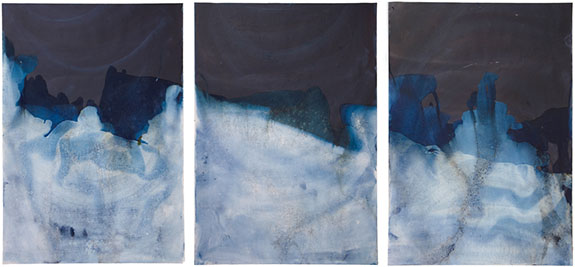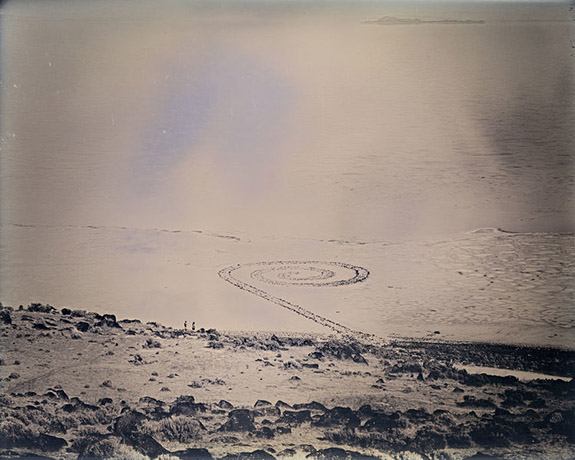by David M. Roth

Water may not be a cure-all, but without it life is a desert. The particular “desert” implicated by A Cure for Everything, a photo exhibit built around depictions of water, is photography itself. In recent years it’s been subverted by two closely related trends: the rise of digital technology and its incorporation into conceptual practices in which political concerns and issues of identity have overriden aesthetic values. Lost is the sense wonder that once accompanied the creation of images made by chemical means. If you long for those seemingly distant pleasures, this line-up of top-tier artists offers a vivifying antidote to the barren condition into which photography has of late fallen.
Each of the artists is on view is a master in their respective realm. Collectively they belong to what’s been called the antiquarian avant-garde, a term coined to denote photographers who’ve breathed life into the medium by mining its history and by employing ancient techniques, some of which, like the camera obscura, pre-date the invention of photography in the 1820s.

No less arresting is Binh Danh’s daguerreotype of Spiral Jetty, Robert’s Smithson’s epic earthwork. Located at Rozel Point on the Great Salt Lake, it is often submerged, and therefore visible at only certain times of year. Dahn’s anamorphic photo fully encapsulates that aspect. Its features fade in and out as you move from side to side, its silvery surface simultaneously revealing and concealing Smithson’s iconic intrusion.
Chris McCaw’s “Sunburns,” made with large hand-built cameras, chart the movement of the sun by burning pinholes and/or incisions into paper negatives that the artist exposes for up to 24 hours. The heat solarizes the paper’s gelatin silver coating, reversing the normal tonal
 |
relationships. As a result, seascapes shot in daylight appear to be illuminated by midnight sun. Odd as that may be, it’s the cuts and holes that stand in memory. They make literal Roland Barthes’ notion of the punctum – that which pierces or produces wounds. To “inflict” them McCaw doesn’t consult a light meter or peer through a viewfinder. He sniffs the air. When smoke wafts from the bellows of his cameras he knows a picture is ready. “It smells like marshmallows roasting,” he told me in 2011.
 |
Works such these hark back to photography’s beginnings, when practitioners were as much chemists as artists, when fragile glass plates and mobile darkrooms were hauled across the landscape in mule-drawn wagons, and when exposure times were typically measured in minutes, not fractions of a second. To make pictures artists had no choice but to immerse themselves in the elements, natural and chemical. Danh’s revival of the daguerreotype, a technique invented in 1839, best illustrates the challenges and rewards of such approaches. “To create a daguerreotype,” he explains on his website, “a silver plate is made sensitive to light by fuming it over iodine and bromine vapor. The plate is then exposed to light in a camera and developed over warm mercury vapor to reveal the latent image…The image is composed onto copper plated with a thin layer of pure silver. Since the image is not on a paper fiber support, a daguerreotype will outlast most any other contemporary photograph. Beautiful examples of 19th century daguerreotypes (about 170 years old) are collected by museums all around the world.”

John Chiara, pushes even further back in time. He employs a camera obscura, better known as a pinhole camera, a technique theorized to have originated in Paleolithic times and used to create everything from cave paintings to Renaissance masterpieces. Chiara’s version of it is a big box on wheels outfitted with a lens that projects images onto positive color photo paper. One glistening seascape produced by this method, Cabrillo Highway at Pescadero Creek Road, Variation 4, portrays water in a way I’ve witnessed in nature only twice: once at Point Lobos, in a cove said to have been a favored hunting spot of 19th century whalers, and again on a whale-watching trip to the Farallones where nutrient-rich waters at the continental shelf displayed the viscosity of spent motor oil. All of which is to say: Chiara’s photos cloak familiar things in strange auras that challenge the objectivity posited by “straight” photography.

Archival Pigment Print | 48 x 48 inches
Linda Connor who’s made a career documenting sacred places presents two small black-and-white prints. One, created at Tanah Lot, a rock island temple in Bali, is particularly haunting; it's s a slow-shutter, sepia-tinged shot of people gathered around a tide pool. Framed by water, sky and rock, the blurred figures call to mind 19th and early 20th century Pictorialism.
The exhibition also includes a 1963 Roy Lichtenstein lithograph of a weeping girl, a Kota Ezawa light box (picturing a flooded city) and a video by Johanna Billing documenting a chilly boat ride. They keep the water theme running. But the more resonant idea coursing through
 |
the show is “better living through chemistry.” Generally speaking, it's probably not a motto to live by. DuPont used it as an advertising slogan in the 1930s. Timothy Leary later repurposed it in the 1960s to proselytize for LSD. But for photographers intent on reaching viewers through aesthetic appeals, the old, chemical-based methods of image making continue to work wonders.
# # #
“A Cure for Everything” @ Haines Gallery through March 2, 2019.
About the author:
David M. Roth is the editor and publisher of Squarecylinder.